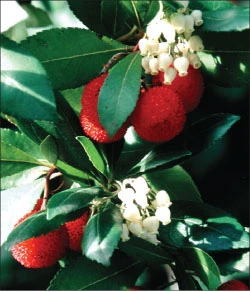
|
|
Arbutus unedo (strawberry tree) is a four-season evergreen shrub with outstanding flowers, fruit, leaves and bark on an easy-to-grow plant. It’s a gift-wrapped landscape beauty.
The small, urn-shaped, whitish-pink flowers are produced from October to December. Unless winter weather is severe enough to damage flowers, they develop into round, ¾-inch, knobby fruits that gradually ripen to orange-red throughout the year -- hence the common name.
This is one of the few large shrubs that flowers in early winter, just at the time the fruit is ripening. Strawberry tree also has attractive, cinnamon-colored bark and rounded, glossy, medium-green leaves.
The flowers are similar to some of the other members in the heath family such as Vaccinium (huckleberry) and Arctostaphylus (manzanita). The bark of Arbutus unedo, much like the madrone tree (Arbutus menzii) peels with age. The leaves are leathery and serrated, with red stems.
The Irish call it the Killarney strawberry tree and it grows along the coast, however, it is also native to Israel. This surprising geographical separation is the result of the Gulf Stream, whose warm waters affect coastal Ireland, Scotland and Britain, creating milder winters, which Arbutus need.
In the landscape
This handsome shrub can be used as an informal hedge or sheared for a more formal look. It may also be planted as a focal point, carefully pruned to accentuate the branch structure and beautiful bark.
Arbutus unedo tolerates a wide variety of soil conditions. It grows best in part or full sun and is drought tolerant once established. There are few insect and disease problems, though it can occasionally get aphids and there may be fungal spotting on older leaves if grown in very poor soil. Foliage and flowers may be damaged in extremely cold winters.
Ten-year height is about 8 feet high by 6-7 feet wide if left unpruned. Eventually it can grow to 15-20 feet high and nearly as wide.
It’s hardy in USDA Hardiness Zones 7-9.
Some cultivars
‘Compacta’ features white flowers and grows to about 6 feet high and wide.
‘Elfin King’ can grow as small as 3 feet high or up to 6 feet high.
‘Oktoberfest’ sports deep pink urn-shaped flowers in drooping clusters.
For more: Elisabeth Carey Miller Botanical Garden/Great Plant Picks, www.greatplantpicks.org. San Francisco Botanical Garden, www.sfbotanicalgarden.org.

Explore the June 2010 Issue
Check out more from this issue and find your next story to read.
Latest from Nursery Management
- John Ruter shares UGA's latest woody and herbaceous ornamental plant breeding projects
- Conor Foy joins EHR's national sales team
- Pantone announces its 2026 Color of the Year
- Syngenta granted federal registration for Trefinti nematicide/fungicide in ornamental market
- Get to know Kayela Aeppli
- HILA 2025 video highlights: John Gaydos of Proven Winners
- Q&A with Justin Bartlett
- Be the best choice







